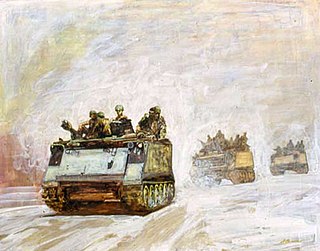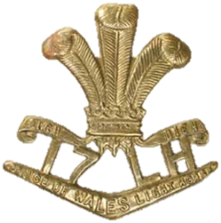
Australian Light Horse were mounted troops with characteristics of both cavalry and mounted infantry, who served in the Second Boer War and World War I. During the inter-war years, a number of regiments were raised as part of Australia's part-time military force. These units were gradually mechanised either before or during World War II, although only a small number undertook operational service during the war. A number of Australian light horse units are still in existence today.

Queen Alexandra's Mounted Rifles (QAMR) is an armoured regiment of the New Zealand Army and forms part of the Royal New Zealand Armoured Corps. The regiment was formed in 1864 and is currently an armoured cavalry unit equipped with NZLAV.

The Royal Australian Armoured Corps (RAAC) is an administrative corps of the Australian Army. It provides the Australian Defence Force's Armour capability, which performs the function of mounted combat. Armour combines firepower, mobility, protection and networked situational awareness to generate shock action and overmatch in close combat. Armour is an essential element of the combined arms approach that is employed by the Australian Army.

1st Armoured Regiment is an armoured regiment of the Australian Army and is the senior regiment of the Royal Australian Armoured Corps. Formed as a tank unit in the new Australian Regular Army on 7 July 1949, the regiment subsequently saw service during the Vietnam War operating Centurion tanks. Currently the unit is based in Edinburgh, South Australia as part of the 9th Brigade. As part of the Plan Beersheba reorganisation, the unit has become one of three Armoured Cavalry Regiments (ACRs) assigned to the Army's multirole combat brigades in Brisbane, Darwin and Townsville. Each ACR is equipped with M1A1 tanks and ASLAV light armoured vehicles.

The 2nd Cavalry Regiment is an armoured cavalry regiment of the Australian Army. Formed in 1965 as the "1st Cavalry Regiment", it is the second most senior regiment in the Royal Australian Armoured Corps. In 1970, the regiment was redesignated as the "2nd Cavalry Regiment", to differentiate it from the 1st Armoured Regiment. The regiment was based at Holsworthy until 1992 when it was allocated to the 1st Brigade based in Darwin in the Northern Territory. In late 2014 the regiment was transferred to the 3rd Brigade, and is now based in Townsville in Queensland. The unit is equipped with M1A1 tanks, ASLAV light armoured vehicles and M113AS4 APCs.

The 2nd/14th Light Horse Regiment is a regiment of the Australian Army and forms part of the Royal Australian Armoured Corps. The regiment is an Australian Light Horse unit, and has been widely romanticised and popularised in literature and poetry throughout the 20th century. The unit sentimentally traces its lineage to 1860 and is the oldest Australian Regular Army unit through antecedent units the 2nd Moreton Light Horse (QMI) and the 14th West Moreton Light Horse (QMI). The regiment is assigned to 7th Brigade based in Brisbane and is equipped with the Boxer Combat Reconnaissance Vehicle, the ASLAV Reconnaissance Vehicle and the M1A1 Abrams main battle tank.

Armoured cavalry are military units using armoured fighting vehicles (AFVs) instead of horses. They began to replace horse cavalry in the heavy shock and the light reconnaissance, skirmishing and exploitation/pursuit roles in most armies commencing after the First World War. In that succeeding capacity, the obsolete name "cavalry" was retained.

The 1st Royal New South Wales Lancers was an Australian Army light cavalry (reconnaissance) regiment. Its complicated lineage includes the New South Wales Lancers which was first formed as a colonial unit in 1885 as the New South Wales Cavalry, and subsequently saw action in the Second Boer War, and later during First World War at Gallipoli and Palestine as the 1st Light Horse Regiment. The unit subsequently served during the Second World War as the 1st Armoured Regiment equipped with Matilda tanks, fighting the Japanese in New Guinea and Borneo.

The 12th/16th Hunter River Lancers is an Australian Army Reserve cavalry regiment. It was formed on 1 May 1948, although it draws its lineage from units that were originally formed in the 1880s. It is currently a Heavy Cavalry unit equipped with Bushmaster Protected Mobility Vehicles. The regiment forms part of the 11th Brigade, attached to the 2nd Division and draws its members from regional centres in northern New South Wales, hence the reference to the Hunter River. Since 2000 the regiment has provided individuals as reinforcements to round-out Regular Army units deploying overseas on peacekeeping operations and in the conflicts in Iraq and Afghanistan.

The 1st Armoured Personnel Carrier Squadron was an armoured unit of the Australian Army raised for service during the Vietnam War. Raised in 1965, the unit was deployed to South Vietnam in May 1966 to join the 1st Australian Task Force. After that 1 APC Sqn was involved in numerous operations in support of the 5th and 6th Battalions, the Royal Australian Regiment, with the most notable action coming on 18 August 1966 when the squadron was involved in the Battle of Long Tan. In January 1967, 1 APC Sqn was redesignated as 'A' Squadron, 3rd Cavalry Regiment.

The 3rd/9th Light Horse is a Reserve light cavalry regiment of the Australian Army based in Smithfield, South Australia. It is constituted of a single squadron. It is part of the Royal Australian Armoured Corps (RAAC), the regiment is attached to the 9th Brigade, and currently operates Hawkei Protected Mobility Vehicle - Light (PMV-L). On 26 October 2022, 9th Brigade transitioned as a Direct Command to Forces Command (FORCOMD) as part of an Army wide transformation. 3rd/9th Light Horse, 1st Armoured Regiment officially commenced on 1 November 2022.

The 10th Light Horse Regiment is a "mounted infantry" regiment of the Australian Army Reserve, raised in Western Australia (WA).

The 3rd Light Horse Regiment was a mounted infantry regiment of the Australian Army during the First World War. The regiment was raised in September 1914, and by December as part of the 1st Light Horse Brigade had moved overseas. The regiment only fought against the forces of the Ottoman Empire, in Egypt, at Gallipoli, on the Sinai Peninsula, and in Palestine and Jordan. After the armistice the regiment eventually returned to Australia in March 1919. For its role in the war the regiment was awarded nineteen battle honours.

The 4th Light Horse Regiment was a mounted infantry regiment of the Australian Army during the First World War. The regiment was raised in August 1914, as the divisional cavalry regiment for the 1st Division. The regiment fought against the forces of the German Empire and the Ottoman Empire, in Egypt, at Gallipoli, on the Western front, on the Sinai Peninsula, and in Palestine and Jordan. After the armistice the regiment eventually returned to Australia in March 1919. For its role in the war the regiment was awarded twenty-one battle honours.

The 6th Light Horse Regiment was a mounted infantry regiment of the Australian Army during the First World War. The regiment was raised in September 1914, and assigned to the 2nd Light Horse Brigade. The regiment fought against the forces of the German Empire and the Ottoman Empire, in Egypt, at Gallipoli, on the Sinai Peninsula, and in Palestine and Jordan. After the armistice the regiment eventually returned to Australia in March 1919. For its role in the war the regiment was awarded sixteen battle honours. During the inter-war years, the regiment was re-raised as a part-time unit based in New South Wales, adopting the designation of the "New South Wales Mounted Rifles". It was later converted to a motor regiment during the early years of the Second World War before being redesignated as an armoured car regiment. Nevertheless, it was disbanded in early 1943 without having been deployed overseas. During the post war years, the regiment was re-raised as part of the Citizens Military Force, and in 1956 was converted into an infantry unit, and in 1960 was subsumed into the Royal New South Wales Regiment.

The 13th Light Horse Regiment was a mounted infantry regiment of the Australian Army during the First World War. The regiment was raised in March 1915, and eventually assigned as the mounted regiment for the Australian Corps. During the war the regiment fought against the forces of the Ottoman Empire, at Gallipoli, and against the German Empire on the Western Front. For its role in the war the regiment was awarded twelve battle honours. In 1921, it was later re-raised as a part-time unit of the Citizens Forces, and was briefly amalgamated with the 19th Light Horse. During the Second World War, the regiment was converted into an armoured regiment, designated the "13th Armoured Regiment", although it was disbanded in late 1943 without seeing action.

The 15th Light Horse Regiment was a mounted infantry regiment of the Australian Army during the First World War. The regiment was raised in Palestine in 1918, from soldiers that had been serving with the Imperial Camel Corps Brigade, and assigned to the 5th Light Horse Brigade. During the war the regiment fought against the forces of the Ottoman Empire, in the Sinai and Palestine Campaign and was awarded fourteen battle honours. During the inter-war years, the regiment was re-raised as a part-time unit based in the Northern Rivers region of New South Wales. It was later converted to a motor regiment during the Second World War but was disbanded in 1944 without having been deployed overseas. In the post war period, the regiment was briefly re-formed, before being amalgamated into the 1st/15th Royal New South Wales Lancers in 1956.
The 8th/13th Victorian Mounted Rifles was an armoured regiment of the Australian Army Reserve. Formed in 1948, the regiment initially operated M3 Grant medium tanks, but was later re-equipped with Centurion tanks in the late 1950s. Operating out of several depots across northern Victoria and southern New South Wales, throughout the 1950s, 60s and 70s the regiment undertook both an armoured and reconnaissance role operating both tanks and armoured cars before being re-equipped with M113A1 armored personnel carriers in the early 1970s. In 1976, the regiment was reduced to a squadron sized element. It was eventually merged with the 4th/19th Prince of Wales's Light Horse in 1992.

The 17th Light Horse Regiment (Prince of Wale's Light Horse) was a Citizens Military Force (CMF) unit of the Australian Light Horse, formed during the 1912 reorganisation of the Australian Army. The regiment traces its origins back to the militia cavalry regiments raised in the colony of Victoria, such as the Royal Volunteer Cavalry Regiment, the Prince of Wales's Light Horse Hussars and the Sandhurst Cavalry Troop.

The 20th Pioneer Battalion was an Australian Army pioneer unit that served in New Guinea during World War II. A Militia unit, the battalion was originally formed as a light horse regiment in 1918. Through the 20th Light Horse Regiment, the unit drew lineage back to early Victorian colonial forces, raised in 1885. During the early part of World War II, the unit was converted from a light horse regiment to a motorised unit – the 20th Motor Regiment – and undertook defensive duties in Victoria and then Queensland. In 1944, it deployed in a dismounted role to Merauke in Dutch New Guinea, to defend the Allied airfield that had been constructed there. The unit was later converted into a pioneer battalion in early 1945, deploying to New Guinea in the final stages of the war. It was disbanded in November 1945.






















